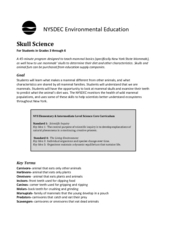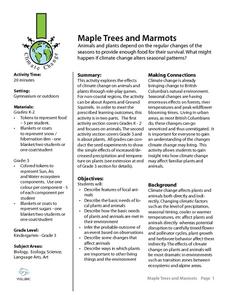Curated OER
Environmental Requirements
All aspects of soil and its components are reviewed here. Your class will learn how certain organisms help the quality of the earth and support growth. Different ways to enhance the chemical make-up are described and will be valuable...
Curated OER
Tracking the Salt Front
Using the Hudson River as the focus, learners discuss the difference between salt water and fresh water environments, analyze maps and graphs, and complete addition and subtraction problems. This activity comes with a wealth of...
Curated OER
Skull Science
What can your class learn from a skull? With proper facilitation, they can learn about diet, physical adaptations, special differences, and even the environment. Pupils will examine a series of mammal skulls and pelts to help them...
Curated OER
Do We Need to Wear a Rainhat? Acid Rain: Causes, Effects, and Possible Solutions
Acid rain, and how it affects the environment, is the focus of this Earth science lesson plan. During the study, learners evaluate measures to reduce acid rain, and design an investigation to demonstrate the conection between a...
Curated OER
Writing Exercises: Early Peoples
Human prehistory is an exciting topic for many learners! Engage your social studies class in critical thinking by having them answer the three short essay questions on this worksheet. They need to know why prehistoric people migrate, how...
Curated OER
Writing Exercises: Economic and Social Revolutions IV
Any revolution is going to impact both society and economy. The class works to grasp the effect of industrialization on the environment, government, and politics. They respond to three critical thinking questions which require them to...
Curated OER
Promoting Self-Esteem Through Positive Interaction
Use a strong student/teacher relationship to foster a trusting environment.
American Institute of Architects
Architecture: It's Elementary!—First Grade
Build an interest and appreciation for architecture in your young learners with this fun 10-lesson art unit. Engaging children in using their five senses, the class first observes the environment around them, paying special attention to...
UAF Geophysical Institute
Carbon Footprint
Your young environmentalists can calculate their carbon footprint and discuss ways to reduce it with a worksheet about climate change. After reading a handout about what impact one's carbon footprint can have on the environment, kids...
Curated OER
Getting Parents On Your Side
Strong ties between parents and teachers produce a learning environment that benefits everyone.
Curated OER
Home Living / Daily Living: Safety Terms
Being able to recognize safety signs in your environment is a great start to staying safe. Kids with severe to moderate disabilities work to recognize and identify safety terms and signs. They use flashcards and decreasing prompts to...
Indian Land Tenure Foundation
Respect for Land
Youngsters examine how people show respect and care for the land. Specifically, learners see how the Native Americans truly did care for and respect the land, and still do so to this day! They also explore how they themselves can care...
California Academy of Science
Climate Change Impacts
Getting kids thinking about climate change now, will hopefully push them into action when they become adults. Young environmentalists discuss the evidence and causes of climate change seen in the state of California. They brainstorm ways...
Earth Day Network
Healthy Earth, Sick Earth
Earth is sick and needs our help! Read the children's book Planet Earth Gets Well to explain the various problems facing the planet, discussing what young conservationists can do to heal the planet along the way. A great Earth Day...
Wild BC
Maple Trees and Marmots
Kinesthetic activities simulate animal activity as the seasons progress in a lesson that introduces climate change to primary pupils. The kids role-play maple trees collecting what they need to survive, but as each year comes around, the...
Owl Teacher
Introduction to World Geography
Give your learners a thorough overview of what they will learn when studying geography, from the five themes of geography (location, place, environment, movement, and regions) to the tools of a geographer and parts of a map.
Curated OER
End-of-Year Practice Test (Grade 11 ELA/Literacy)
Set up a solid foundation for learners going into Common Core testing by taking some time to complete this practice test. Class members answer questions about both literary and informational texts, with an emphasis on textual evidence....
Dick Blick Art Materials
Very, Very Simple Decorative Papers
Combine art and science with an activity that has kids gathering items from their environment to include in the decorative paper they create.
New South Wales of Education and Communities
Setting the Scene
How to establish a safe classroom environment for discussion is the focus of this introduction to a series of six resources devoted to personal safety.
It's About Time
Factors Affecting Population Size
How do we predict future population growth? Young researchers investigate various factors affecting the size of our population. As they calculate and interpret graphs to determine factors that could potentially affect increases and...
Curated OER
Committing to Respect: Lessons for Students to Address Bias
Here's a guide designed to build safe, respectful learning environments, and to build understanding of the value of diversity through lessons packed with activities for specific grade levels.
NASA
Lights on the International Space Station
Groups explore illumination with NASA's Lighting Environment Test Facility (LETF) as a context. Using the TI-Nspire app, groups determine the lux equation that models their simulation. They then use the lux equation to solve problems...
Newspaper Association of America
Critical Thinking through Core Curriculum: Using Print and Digital Newspapers
What is and what will be the role of newspapers in the future? Keeping this essential question in mind, class members use print, electronic, and/or web editions of newspapers, to investigate topics that include financial literary,...
New York State Department of Environmental Conservation
Adaptations – Designs for Survival
What's the difference between behavioral adaptations and physical adaptations? Learn about the various ways that organisms adapt to their environment with a worksheet about the creatures of the Hudson River.
Other popular searches
- Extreme Environments
- Different Environments
- Urban Environments
- Desert Environments
- Deep Sea Environments
- Marine Environments
- Creating Safe Environments
- Estuary Environments
- Animal Environments
- Earth Environments
- Natural Environments
- Canadian Environments

























